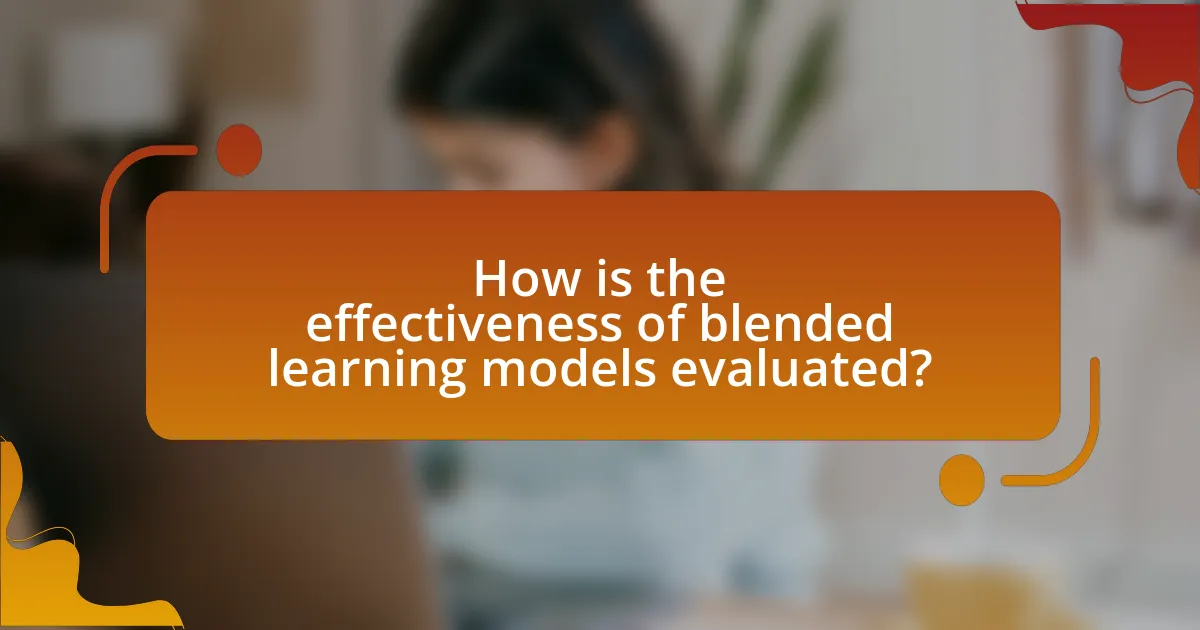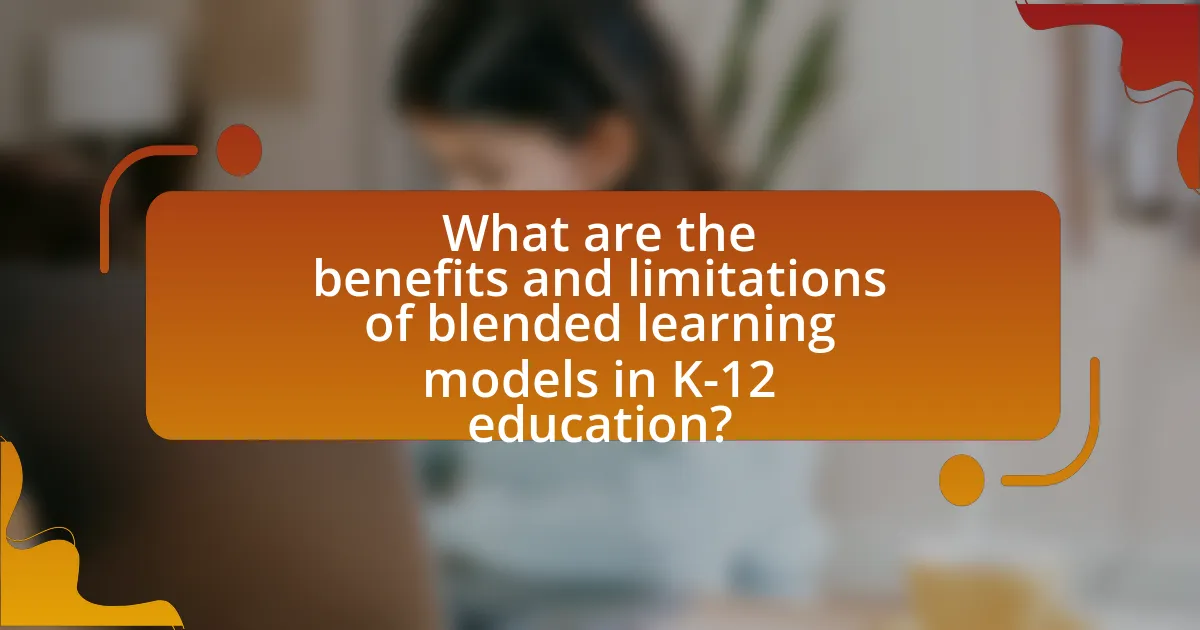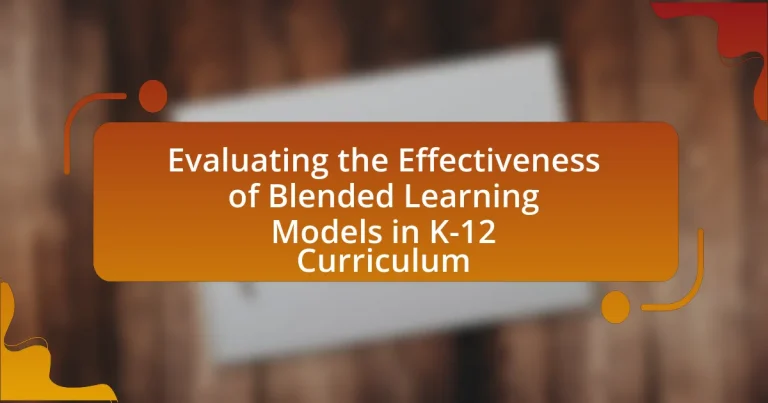The article evaluates the effectiveness of blended learning models in K-12 curriculum, which combine traditional face-to-face instruction with online learning activities. It outlines various blended learning models, such as the rotation, flex, and self-blend models, and discusses their key components, including personalized learning pathways and technology integration. The article highlights research findings that indicate blended learning can enhance student engagement and academic achievement, while also addressing challenges such as technology access disparities and the need for teacher training. Additionally, it examines metrics for evaluating blended learning effectiveness, including standardized test scores and qualitative measures of student experience.

What are Blended Learning Models in K-12 Curriculum?
Blended learning models in K-12 curriculum integrate traditional face-to-face classroom methods with online learning activities. These models vary in structure, including the rotation model, where students alternate between in-person and online instruction, and the flex model, which offers a more personalized approach with online resources guiding the majority of learning while teachers provide support as needed. Research indicates that blended learning can enhance student engagement and achievement; for instance, a study by the U.S. Department of Education found that students in blended learning environments performed better than those in traditional settings, highlighting the effectiveness of this approach in modern education.
How do blended learning models differ from traditional learning methods?
Blended learning models integrate both online and face-to-face instruction, while traditional learning methods rely solely on in-person classroom experiences. This integration allows for personalized learning experiences, where students can progress at their own pace through online resources, unlike the fixed pace of traditional classrooms. Research indicates that blended learning can lead to improved student engagement and achievement, as evidenced by a study from the U.S. Department of Education, which found that students in blended learning environments performed better than those in traditional settings.
What are the key components of blended learning models?
The key components of blended learning models include a combination of online and face-to-face instruction, personalized learning pathways, and the integration of technology to facilitate learning. Blended learning effectively merges traditional classroom experiences with digital resources, allowing for a more flexible and tailored educational approach. Research indicates that this model enhances student engagement and achievement by accommodating diverse learning styles and paces, as evidenced by studies showing improved outcomes in K-12 settings when technology is utilized alongside direct instruction.
How do these components interact within the K-12 curriculum?
The components of blended learning models interact within the K-12 curriculum by integrating traditional face-to-face instruction with online learning resources, creating a cohesive educational experience. This interaction allows for personalized learning pathways, where students can progress at their own pace through digital content while still benefiting from direct teacher support. Research indicates that blended learning can enhance student engagement and achievement; for instance, a study by the U.S. Department of Education found that students in blended learning environments performed better than those in traditional settings, highlighting the effectiveness of this model in fostering academic success.
What are the various types of blended learning models?
The various types of blended learning models include the Rotation Model, Flex Model, A La Carte Model, Enriched Virtual Model, and the Self-Blend Model. The Rotation Model involves students rotating between different learning modalities, such as online and face-to-face instruction. The Flex Model provides a primarily online learning experience with occasional in-person support. The A La Carte Model allows students to take some courses online while attending traditional classes for others. The Enriched Virtual Model combines online coursework with mandatory in-person sessions. Lastly, the Self-Blend Model enables students to choose online courses to supplement their traditional education. These models are designed to enhance learning flexibility and accessibility in K-12 education.
What is the rotation model and how is it implemented?
The rotation model is a blended learning approach where students rotate between different learning modalities, such as online learning, face-to-face instruction, and independent study. This model is implemented by scheduling specific times for students to engage in each modality, allowing for personalized learning experiences and flexibility in pacing. For example, in a typical rotation model, students might spend part of their day in a traditional classroom setting with a teacher, then rotate to an online platform for self-paced learning, and finally engage in collaborative projects or independent study. Research indicates that this model can enhance student engagement and improve learning outcomes by catering to diverse learning styles and needs.
What is the flex model and what are its advantages?
The flex model is a blended learning approach where students learn primarily online, with teachers providing support and instruction as needed. This model allows for personalized learning experiences, enabling students to progress at their own pace while receiving targeted assistance from educators. Advantages of the flex model include increased student engagement through interactive online content, flexibility in learning schedules, and the ability to tailor instruction to meet individual learning needs, which has been shown to improve academic outcomes in K-12 settings. Research indicates that personalized learning environments, such as those created by the flex model, can lead to higher student achievement and satisfaction.
How does the self-blend model cater to individual student needs?
The self-blend model caters to individual student needs by allowing students to choose the pace and style of their learning, which promotes personalized education. This model combines traditional classroom instruction with online learning, enabling students to access resources that align with their specific learning preferences and requirements. Research indicates that personalized learning approaches, such as the self-blend model, can lead to improved student engagement and academic performance, as they empower students to take ownership of their learning journey.
What are the goals of implementing blended learning in K-12 education?
The primary goals of implementing blended learning in K-12 education are to enhance student engagement, personalize learning experiences, and improve academic outcomes. Blended learning combines traditional face-to-face instruction with online learning, allowing for a more flexible and tailored educational approach. Research indicates that this model can lead to increased motivation and participation among students, as it accommodates diverse learning styles and paces. For instance, a study by the U.S. Department of Education found that students in blended learning environments performed better than those in traditional settings, highlighting the effectiveness of this approach in achieving educational goals.
How does blended learning aim to enhance student engagement?
Blended learning aims to enhance student engagement by integrating online and face-to-face instructional methods, allowing for personalized learning experiences. This approach facilitates greater flexibility in learning, enabling students to access resources at their own pace and revisit materials as needed, which has been shown to improve retention and understanding. Research indicates that blended learning environments can lead to increased motivation and participation, as students often find the interactive online components more engaging compared to traditional methods. For instance, a study by Graham et al. (2013) found that students in blended learning settings reported higher levels of engagement and satisfaction compared to those in purely traditional classrooms.
What role does personalized learning play in blended models?
Personalized learning is essential in blended models as it tailors educational experiences to meet individual student needs, preferences, and learning paces. This approach enhances student engagement and motivation by allowing learners to take control of their educational journey, which is particularly effective in K-12 settings. Research indicates that personalized learning can lead to improved academic outcomes; for instance, a study by the Bill & Melinda Gates Foundation found that schools implementing personalized learning saw significant gains in student achievement compared to traditional models. By integrating personalized learning within blended models, educators can create a more adaptive and responsive learning environment that supports diverse learners effectively.

How is the effectiveness of blended learning models evaluated?
The effectiveness of blended learning models is evaluated through a combination of quantitative and qualitative metrics, including student performance data, engagement levels, and feedback surveys. Research indicates that standardized test scores and grades are commonly used to assess academic achievement in blended environments, while student engagement can be measured through participation rates and completion of assignments. Additionally, qualitative feedback from students and teachers provides insights into the learning experience, highlighting areas for improvement. Studies, such as those conducted by the U.S. Department of Education, have shown that blended learning can lead to improved outcomes when implemented effectively, reinforcing the importance of these evaluation methods.
What metrics are used to assess the effectiveness of blended learning?
Metrics used to assess the effectiveness of blended learning include student engagement, academic performance, retention rates, and learner satisfaction. Student engagement can be measured through participation in online discussions and completion of assignments, while academic performance is often evaluated through test scores and grades. Retention rates indicate how many students continue in the program, and learner satisfaction is typically assessed through surveys and feedback forms. Research has shown that these metrics provide a comprehensive view of how blended learning impacts student outcomes, with studies indicating that higher engagement correlates with improved academic performance.
How do standardized test scores reflect the success of blended learning?
Standardized test scores serve as a quantitative measure of student learning outcomes, reflecting the effectiveness of blended learning models in K-12 education. Research indicates that students engaged in blended learning environments often demonstrate improved performance on standardized assessments compared to their peers in traditional settings. For instance, a study by the U.S. Department of Education found that students in blended learning programs scored, on average, 10% higher on standardized tests than those in conventional classrooms. This improvement can be attributed to the personalized learning experiences and increased engagement facilitated by blended learning, which combines online and face-to-face instruction. Thus, higher standardized test scores can be interpreted as evidence of the successful implementation of blended learning strategies in enhancing student achievement.
What qualitative measures are important in evaluating student experience?
Qualitative measures important in evaluating student experience include student feedback, engagement levels, and peer interactions. Student feedback, gathered through surveys and interviews, provides insights into their perceptions of the learning environment and instructional methods. Engagement levels can be assessed through observations of participation in discussions and activities, indicating how invested students are in their learning. Peer interactions, evaluated through group work and collaborative projects, reveal the social dynamics and support systems within the classroom. These measures collectively contribute to a comprehensive understanding of the student experience in blended learning models.
What challenges are faced in evaluating blended learning effectiveness?
Evaluating blended learning effectiveness faces several challenges, including the difficulty in measuring learning outcomes due to the integration of both online and face-to-face components. This complexity arises because traditional assessment methods may not adequately capture the nuances of student engagement and learning in a blended environment. Additionally, variations in implementation across different classrooms can lead to inconsistent data, making it hard to generalize findings. Research indicates that factors such as teacher training, student motivation, and technological access significantly influence the effectiveness of blended learning, complicating the evaluation process. For instance, a study by Graham et al. (2013) highlights that without standardized metrics, comparing the effectiveness of blended learning to traditional methods becomes problematic.
How do varying definitions of success complicate evaluations?
Varying definitions of success complicate evaluations by creating ambiguity in assessment criteria. In the context of blended learning models in K-12 curriculum, success can be defined in multiple ways, such as academic performance, student engagement, or social-emotional development. This multiplicity leads to challenges in establishing standardized metrics for evaluation, making it difficult to compare outcomes across different educational settings. For instance, a study by the Bill & Melinda Gates Foundation found that when success is defined solely by test scores, other important factors like student satisfaction and critical thinking skills may be overlooked, resulting in an incomplete assessment of the blended learning model’s effectiveness.
What role does teacher training play in the evaluation process?
Teacher training is essential in the evaluation process as it equips educators with the necessary skills and knowledge to effectively assess student learning outcomes. Trained teachers are better prepared to implement evaluation strategies that align with blended learning models, ensuring that assessments are both relevant and comprehensive. Research indicates that professional development programs significantly enhance teachers’ assessment literacy, which directly impacts the quality of evaluations conducted in K-12 settings. For instance, a study by Darling-Hammond et al. (2017) found that teachers who participated in targeted training demonstrated improved assessment practices, leading to more accurate evaluations of student performance.
What are the implications of evaluation results for future blended learning initiatives?
Evaluation results for blended learning initiatives indicate critical areas for improvement and inform future design decisions. Specifically, data from evaluations can reveal which instructional strategies are most effective, guiding educators to refine their approaches. For instance, a study by the U.S. Department of Education found that blended learning can lead to improved student outcomes when tailored to individual learning needs. This evidence suggests that future initiatives should prioritize personalized learning experiences and incorporate feedback mechanisms to continuously adapt and enhance the blended learning environment. Additionally, evaluation results can highlight gaps in technology access or teacher training, prompting necessary investments in resources and professional development to ensure equitable and effective implementation.
How can data from evaluations inform curriculum adjustments?
Data from evaluations can inform curriculum adjustments by identifying areas where students struggle and highlighting effective teaching strategies. For instance, standardized test scores and formative assessments can reveal specific content areas that require more focus or different instructional approaches. Research shows that using data analytics in education can lead to a 10-20% improvement in student performance when curriculum changes are based on evaluation results. By analyzing this data, educators can tailor the curriculum to better meet the needs of diverse learners, ensuring that instructional methods align with student learning outcomes.
What best practices can be derived from successful blended learning evaluations?
Best practices derived from successful blended learning evaluations include the integration of formative assessments, personalized learning pathways, and consistent feedback mechanisms. Formative assessments allow educators to gauge student understanding in real-time, enabling timely interventions. Personalized learning pathways cater to individual student needs, enhancing engagement and motivation. Consistent feedback mechanisms ensure that students receive regular insights into their performance, fostering a growth mindset. Research indicates that these practices lead to improved student outcomes, as evidenced by a study from the Bill & Melinda Gates Foundation, which found that effective feedback significantly enhances learning in blended environments.

What are the benefits and limitations of blended learning models in K-12 education?
Blended learning models in K-12 education offer several benefits and limitations. The primary benefit is the flexibility they provide, allowing students to learn at their own pace and access resources online, which can enhance engagement and accommodate diverse learning styles. Research by the U.S. Department of Education indicates that blended learning can lead to improved student achievement, particularly in subjects like math and reading.
However, limitations include the potential for unequal access to technology, which can exacerbate educational disparities among students. A study by the Pew Research Center found that 15% of U.S. households with school-age children lack high-speed internet, hindering their ability to participate fully in blended learning environments. Additionally, the effectiveness of blended learning heavily relies on teacher training and support, which can vary significantly across schools.
What advantages do blended learning models offer to students?
Blended learning models offer students increased flexibility and personalized learning experiences. These models combine traditional face-to-face instruction with online learning, allowing students to learn at their own pace and access resources anytime. Research indicates that students in blended learning environments often demonstrate improved engagement and academic performance. For instance, a study by the U.S. Department of Education found that students in blended learning settings performed better than those in purely traditional classrooms, highlighting the effectiveness of this approach in enhancing educational outcomes.
How does blended learning support diverse learning styles?
Blended learning supports diverse learning styles by integrating both online and face-to-face instructional methods, allowing for personalized learning experiences. This approach caters to visual, auditory, and kinesthetic learners by providing various formats such as videos, interactive simulations, and hands-on activities. Research indicates that students in blended learning environments often demonstrate improved engagement and retention of information, as they can choose the methods that best suit their individual learning preferences. For instance, a study by Graham et al. (2013) found that blended learning can enhance student satisfaction and performance across different learning styles, confirming its effectiveness in accommodating diverse educational needs.
What impact does blended learning have on student achievement?
Blended learning positively impacts student achievement by combining traditional face-to-face instruction with online learning, leading to improved academic performance. Research indicates that students engaged in blended learning environments often demonstrate higher test scores and greater retention of information compared to those in solely traditional settings. For instance, a study published in the “Journal of Educational Psychology” by Means et al. (2013) found that students in blended learning courses performed better than their peers in conventional classrooms, with an effect size of 0.35, indicating a moderate positive impact on achievement. This evidence supports the conclusion that blended learning can enhance educational outcomes in K-12 settings.
What limitations should educators be aware of when implementing blended learning?
Educators should be aware that blended learning can present limitations such as varying levels of student engagement, technological access disparities, and the need for teacher training. Research indicates that student engagement in blended learning environments can fluctuate significantly, with some students thriving while others struggle due to a lack of motivation or self-regulation skills. Additionally, a study by the Pew Research Center found that approximately 15% of U.S. households with school-age children do not have high-speed internet access, which can hinder equitable participation in blended learning. Furthermore, effective implementation requires educators to possess adequate training in both technology and instructional strategies, as highlighted in a report by the International Society for Technology in Education, which emphasizes that insufficient training can lead to ineffective use of blended learning tools.
How can technology access disparities affect blended learning outcomes?
Technology access disparities can significantly hinder blended learning outcomes by creating unequal opportunities for students to engage with digital resources. When students lack reliable internet access or appropriate devices, their ability to participate in online components of blended learning diminishes, leading to lower academic performance. For instance, a study by the Pew Research Center found that 15% of U.S. households with school-age children do not have high-speed internet, which directly impacts students’ ability to complete assignments and access educational materials. Consequently, these disparities can exacerbate existing achievement gaps, as students with limited access may fall behind their peers who have consistent and reliable technology resources.
What challenges do teachers face in adapting to blended learning environments?
Teachers face several challenges in adapting to blended learning environments, including technological proficiency, student engagement, and curriculum integration. Technological proficiency is crucial, as teachers must be comfortable using various digital tools and platforms; a study by the International Society for Technology in Education found that 70% of educators reported needing more training in technology use. Student engagement poses another challenge, as maintaining motivation in a hybrid setting can be difficult; research indicates that blended learning can lead to decreased student interaction if not managed effectively. Lastly, integrating traditional and online curricula requires careful planning and alignment, which can be time-consuming and complex, as highlighted by a report from the U.S. Department of Education that emphasizes the need for coherent instructional strategies in blended learning.
What strategies can enhance the effectiveness of blended learning models?
Implementing personalized learning pathways enhances the effectiveness of blended learning models. By tailoring educational experiences to individual student needs, educators can improve engagement and learning outcomes. Research indicates that personalized learning can lead to a 30% increase in student performance, as evidenced by a study conducted by the Bill & Melinda Gates Foundation, which found that personalized approaches significantly boost student achievement in K-12 settings. Additionally, integrating technology tools that facilitate real-time feedback allows for immediate adjustments to instruction, further supporting student success in blended environments.
How can educators effectively integrate technology into their teaching?
Educators can effectively integrate technology into their teaching by utilizing blended learning models that combine traditional face-to-face instruction with online learning components. Research indicates that blended learning can enhance student engagement and improve learning outcomes; for instance, a study by Graham et al. (2013) found that students in blended environments performed better than those in purely traditional settings. By incorporating tools such as learning management systems, interactive simulations, and digital collaboration platforms, educators can create a more personalized and flexible learning experience. Additionally, ongoing professional development in technology use is essential, as it equips educators with the skills needed to implement these tools effectively, leading to improved educational practices and student success.
What role does ongoing professional development play in successful implementation?
Ongoing professional development is crucial for the successful implementation of blended learning models in K-12 curriculum. It equips educators with the necessary skills and knowledge to effectively integrate technology and pedagogical strategies into their teaching practices. Research indicates that teachers who engage in continuous professional development are more likely to adopt innovative teaching methods and improve student outcomes. For instance, a study by Darling-Hammond et al. (2017) found that sustained professional development positively impacts teacher effectiveness and student achievement, highlighting the importance of ongoing training in adapting to blended learning environments.
What are practical tips for successfully implementing blended learning in K-12 settings?
To successfully implement blended learning in K-12 settings, educators should prioritize clear communication and collaboration among all stakeholders, including teachers, students, and parents. Establishing a structured framework that combines online and face-to-face instruction enhances engagement and learning outcomes. Research indicates that schools utilizing blended learning models, such as the Flipped Classroom approach, have seen improved student performance and satisfaction. For instance, a study by the U.S. Department of Education found that blended learning can lead to better academic results compared to traditional methods. Additionally, providing professional development for teachers ensures they are equipped with the necessary skills to effectively integrate technology into their teaching practices.


